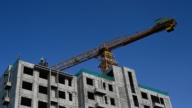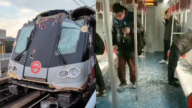【新唐人2011年7月25日讯】7月23号晚8点多,两列动车在中国温州境内追尾相撞,造成6节车厢脱轨,4节坠桥。大陆媒体报导,目前已造成35人死亡,210人受伤。而中共喉舌媒体发布的事故主因,受到业内专家的质疑。
大陆媒体报导说:周六晚上,由浙江杭州开往福建福州的D3115次动车,因铁轨遭到多次雷击而断电失去动力,被迫停靠在温州市附近的一座高架铁路桥上。晚上8点50分,北京南站到福州的D301次动车行驶到此,与这列动车发生追撞,导致D301次动车第1至第4节车厢脱轨,停靠的 D3115次动车的第15、16节车厢被撞脱轨,从高架桥上坠落。高架桥距离地面约为20∼30米。
记者致电给温州医院,院方告诉《新唐人》,他们已经接受了很多的伤者。
温州医院人员:“ 伤患有啊!”
记者:接收到几位了?
温州医院人员:“接收的目前所在院的是29人,接诊的是40多人。”
而温州卫生局则说:已经是35人遇难了,伤患各医院都有。也有温州居民说:死了36个人。
温州市长赵一德表示,两节挤压在一起的车厢里可能还有乘客。初步估算,发生事故的两辆列车中,前 一列大约有900多人,后一列有500多人。
有幸生还的张女士告诉《大纪元时报》,“事故发生时,车厢的灯全灭了,车厢猛烈的颤抖,尖叫声充满了整个车厢,接着就坠下了高铁桥,她赶紧冲出车厢找女儿,但是至今还没找到。
据了解,追撞的列车属CRH系列电联车,在铁道部资料及宣传中,都被视为“高铁列车”。特殊的是,台湾《中央社》报导说,“动车”既在京沪、武广、杭深等“高铁线”上行驶,也在北京到哈尔滨、武汉、成都等地的“一般铁路线”上,与其他火车混合行驶﹔而且行驶在“一般铁路线”上时,时速也在200公里上下。
大陆《经济观察网》报导,列车技术专家告诉记者,“动车”本身具有防备雷电的装置,在受到雷电的干扰后,自控系统会开启,导致停车。但列车上有司机,可以紧急操作。
报导说,多位专家质疑当局的说法。专家提问:“两车之间的相隔安全距离为1000米左右。后车同样有自控系统装置,为什么没有停车?”
文章进一步指出,业内人士分析认为,追尾的第二个原因,可能是调度出了问题。查阅中国铁路客户服务中心网站的列车时刻表显示,在台州至温州南段,应该是D301列车在前,D3115在后。但现实却是相反的。如果按运行时刻安排,即使相撞,也是D3115撞D301。
在新浪微博上有网友已贴出“关于温州7.23动车追尾的十大疑问”,并写道:铁道部开发布会,却只让cctv与《新华社》的记者进入,什么临时工,N年不遇的天灾啊,网友的眼睛是雪亮的,别再想转嫁责任了。
与此同时,中国开通不到一个月的“京沪高铁”,在连续多次出现故障之后,也打击了公众对中国铁路的信心。
温州居民张先生:“如果说让我坐车的话,我选择火车,坐火车还是稳一点啊,动力车你看看,动不动这样那样的,比较怕。”
网友说,“公路冲毁怪雨大,桥梁垮塌怪车超载,动车追尾怪雷击,何时能见人担责?”
新唐人记者刘惠、林慧心、周天采访报导。
Cause of Train Accident Questioned
On July 23, after 8 p.m., two motor trains collided in Wenzhou,
resulting in six cars derailing and four cars falling off a viaduct.
Chinese media reported 35 deaths and 210 injuries.
However, industry experts questioned the cause reported by
the mouthpiece media of the Communist government.
Chinese media reported that on the night of July 23,
Motor train D3115 traveled from Hangzhou to Fujian.
Its track lost power after being struck by lightning.
So, the train was forced to stall on a viaduct near Wenzhou.
At 8:50 p.m., another motor train D301from Beijing to Fuzhou
rear-ended D3115, causing two of D3115’s cars to derail,
and four of D301’s cars to derail and fall off the viaduct.
The viaduct is 20 to 30 meters above the ground.
A hospital in Wenzhou told NTD that
they had received a lot of injured passengers.
Hospital staff: “We have received some wounded passengers."
(Reporter: How many have you received?)
Hospital staff: “Currently, 29 people are hospitalized,
more than 40 people were admitted to the hospital in total."
However, the Wenzhou Health Bureau announced that
35 died and there were wounded people in all local hospitals.
According to some local residents,
36 people had died.
Wenzhou’s mayor Zhao Yide said that
there might still be passengers in two wrecked cars.
It is estimated that there were 900 people in the first train
and 500 people in the second train.
Survivor Ms. Zhang told the Epoch Times that
at the time of the accident, all lights went off in her car,
the car trembled severely, and screams filled the car.
Her daughter’s car then fell off the viaduct.
She rushed out of her car to search for her daughter.
However, she has not yet been found.
Both trains were China Railway High-speed series
electricity-powered trains.
According to Taiwan’s Central News Agency,
electricity-powered trains not only run on high-speed rails,
but also run on general railways along with regular trains
at a speed lower than 200 km/h.
China Economic Observer Online reported,
technical experts said that electricity-powered trains have
lightning protection devices.
Their automatic control system would be activated
to stop the trains after lightning strikes.
But train conductors may carry out emergency operation.
The report questioned the authorities’ explanation.
The experts asked,
“If the safe distance between both trains is 1,000 meters,
why didn’t the 2nd train with automatic control system stop?”
The report also indicated that internal analysts believe that
the second cause of the accident may be a scheduling problem.
China Railway’s online train schedules showed that
from Taizhou to the southern section of Wenzhou,
Train D301 should run ahead of Train D3115.
However, it was not the case.
A netizen posted on Sina’s microblog,
“Ten Questions of 7.23 Rear-end Train Accident in Wenzhou",
“The Ministry of Railways held a conference that only allows
the entrance of CCTV and Xinhua News Agency reporters.
Everyone is watching. Don’t try to shift your responsibility
to temporary workers or natural disasters.”
Meanwhile, the Beijing-Shanghai High-Speed Rail,
which started operation less than a month ago,
had several operational failures.
This has decreased the public confidence in China’s railways.
Wenzhou resident Mr. Zhang,
“I would choose the regular trains over the high-speed trains.
Regular trains are more stable.
I am too scared to take the motor trains.”
A netizen said, “If roads are damaged, the rain is blamed;
If bridges collapse, the cars are blamed for being overloaded;
If trains are rear-ended, the lightning is blamed.
When can people take the responsibility?"
NTD reporters Liu Hui, Lin Huixing and Zhou Tian






























